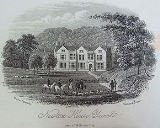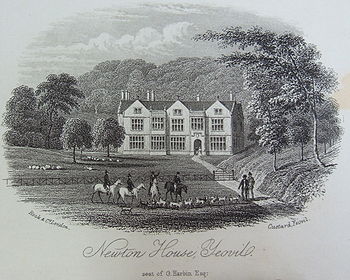
Newton Surmaville
Encyclopedia
Newton Surmaville is a small park and house south of Yeovil
, Somerset
in the district of South Somerset
, in England. It lies just outside the town in the parish of Barwick
.
 The house, which is also known as Newton House, was built between 1608 and 1612, on the site of an earlier building, but was extensively altered and enhanced in the 1870s. It was built for Robert Harbin, a Yeovil merchant. The house still contained much of its original furniture and an eclectic library of many thousands of volumes. There were also 17th-century tapestries, portraying scenes of "Elijah Rising into Heaven and the Melting of the Golden Calf" in sculpted gold frames, and collections of antique pewter
The house, which is also known as Newton House, was built between 1608 and 1612, on the site of an earlier building, but was extensively altered and enhanced in the 1870s. It was built for Robert Harbin, a Yeovil merchant. The house still contained much of its original furniture and an eclectic library of many thousands of volumes. There were also 17th-century tapestries, portraying scenes of "Elijah Rising into Heaven and the Melting of the Golden Calf" in sculpted gold frames, and collections of antique pewter
and pistols and swords
. Some of the contents were given to the Somerset County Museum
, the Somerset Military Museum
and auctioned at Sothebys in London.
It has been designated by English Heritage
as a Grade I listed building. The Surmaville part of the name comes from the de Salmonville family.
There are various outbuildings including the stables, gardeners cottage, and barn.
. They were laid out in the mid 18th century, with further landscaping in the 19th. The pleasure gardens included five ponds, a boathouse, a curving lime avenue canter, a walled kitchen garden, a rose garden and herbaceous borders to the east of the pond accessed via circa 1700 gates. The summerhouse dates from 1750, and was built as a 3-storey octagon with 2-storey flanking wings. It has since been converted into a cottage. The original design of the grounds is described in the memoirs "The Revd George Harbin and his memoirs of gardening 1716-1723".
Yeovil
Yeovil is a town and civil parish in south Somerset, England. The parish had a population of 27,949 at the 2001 census, although the wider urban area had a population of 42,140...
, Somerset
Somerset
The ceremonial and non-metropolitan county of Somerset in South West England borders Bristol and Gloucestershire to the north, Wiltshire to the east, Dorset to the south-east, and Devon to the south-west. It is partly bounded to the north and west by the Bristol Channel and the estuary of the...
in the district of South Somerset
South Somerset
South Somerset is a local government district in Somerset, England.The South Somerset district covers and area of ranging from the borders with Devon and Dorset to the edge of the Somerset Levels. It has a population of approximately 158,000...
, in England. It lies just outside the town in the parish of Barwick
Barwick, Somerset
Barwick is a village and parish in Somerset, England, situated south of Yeovil in the South Somerset district and on the border with Dorset. The parish, which includes the village of Stoford has a population of 1,289.-History:...
.
House

Pewter
Pewter is a malleable metal alloy, traditionally 85–99% tin, with the remainder consisting of copper, antimony, bismuth and lead. Copper and antimony act as hardeners while lead is common in the lower grades of pewter, which have a bluish tint. It has a low melting point, around 170–230 °C ,...
and pistols and swords
Swords
A sword is a cutting/thrusting weapon made of metal. Sword or swords may also refer to:* Swords, County Dublin, Ireland* Suit of swords, a suit in Latin-suited playing cards and Tarot decks* SWORDS, a ground-based military robot...
. Some of the contents were given to the Somerset County Museum
Somerset County Museum
The Museum of Somerset is located in the 12th century great hall of Taunton Castle, in Taunton in the county of Somerset, England. The museum is run by Somerset County Council and includes objects initially collected by the Somerset Archaeological and Natural History Society who own the...
, the Somerset Military Museum
Somerset Military Museum
The Somerset Military Museum is part of the Somerset County Museum located in the 12th century great hall of Taunton Castle, in Taunton, Somerset. It is a "registered and accredited museum" with the British Museums, Libraries, and Archives Council, and is a part of the Museum of Somerset. The...
and auctioned at Sothebys in London.
It has been designated by English Heritage
English Heritage
English Heritage . is an executive non-departmental public body of the British Government sponsored by the Department for Culture, Media and Sport...
as a Grade I listed building. The Surmaville part of the name comes from the de Salmonville family.
There are various outbuildings including the stables, gardeners cottage, and barn.
Grounds
The gardens and pleasure grounds cover around two hectares, and slope down to the River YeoRiver Yeo (South Somerset)
The River Yeo, also known as the River Ivel or River Gascoigne, is a tributary of the River Parrett in north Dorset and south Somerset, England....
. They were laid out in the mid 18th century, with further landscaping in the 19th. The pleasure gardens included five ponds, a boathouse, a curving lime avenue canter, a walled kitchen garden, a rose garden and herbaceous borders to the east of the pond accessed via circa 1700 gates. The summerhouse dates from 1750, and was built as a 3-storey octagon with 2-storey flanking wings. It has since been converted into a cottage. The original design of the grounds is described in the memoirs "The Revd George Harbin and his memoirs of gardening 1716-1723".
Further reading
- Anon, 1906, Yeovil With Its Surroundings The Homeland Handbook Series
- Bates Harbin, E. H., 1910, "History of the Manor of Newton Surmaville" Proceedings of the Somersetshire Archaeological and Natural History Society Vol 56 (Third Series, 16), Part II, 1-30
- Beet, Toni, 2004, Yeovil - a history and celebration of the town Ottakar’s/Francis Frith
- Darling-Finan, Nicola, 2001, Yeovil: A Photographic History of Your Town W. H. Smith/Francis Frith
- Dunning, Robert, 1991, Some Country Houses: A Personal Selection Wimborne: Dovecot Press
- Garner, Thomas and Stratton, Arthur, 1929, The Domestic Architecture of England During the Tudor Period London: B T Batsford Ltd, 2nd edition, revised and enlarged.
- Gerrard, James, 1995, "The Summer House of the Newton Surmaville Estate" Chronicle (the journal of Yeovil Archaeological and Local History Society), Vol 6, No 5, October 1995, 109-111
- Murray, Stephen, 1941, Yeovil, Sherborne and the West Country with a Journey along the Fosse Way to the North Yeovil: Stephen Murray and Co. Ltd.,/The Viking Press
- Nares, Gordon, 1952, "Newton Surmaville, Somerset - I. The Home of Mrs Bates Harbin" Country Life September 5, 1952, 676-69
- Nares, Gordon, 1952, "Newton Surmaville, Somerset - II. The Home of Mrs Bates Harbin" Country Life September 12, 1952, 760-763
- Nares, Gordon, 1952, "Newton Surmaville, Somerset - III. The Home of Mrs Bates Harbin" Country Life September 19, 1952, 844-847
- Nash, Judy, 1993, "Newton Surmaville" The Somerset Magazine September 1993, 47-49
- Pevsner, Nikolaus, 1958, South and West Somerset London: Penguin The Buildings of England series
- Rawlins, Sophia W., 1965, "Newton Surmaville" Proceedings of the Somersetshire Archaeological and Natural History Society for 1964/5, Vol 109, 30-35
- Vickery, Daniel, 1856, A Sketch of the Town of Yeovil

